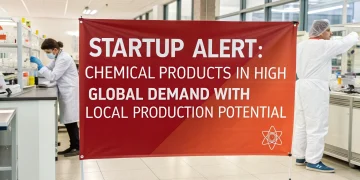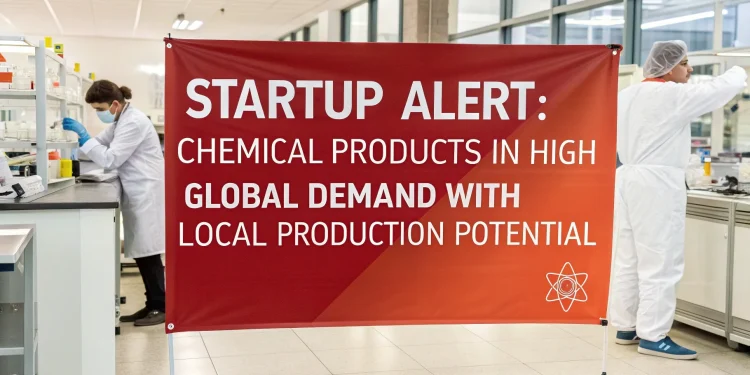Why Chemical Manufacturing Is the Startup Sector to Watch
India is at the start of a new decade revolving around industrial changes. The regions of focus are electric mobility, clean energy, and electronics, while the chemical products sector has been most quietly transforming electric vehicle batteries, and even pharmaceuticals and packaging materials.
Chemicals are now a critical part of agriculture, healthcare, infrastructure, and even emerging technologies like hydrogen storage and semiconductor fabrication. The supply chain, however, is still concentrated and dependent on a few countries. With the move to “China plus one,” companies are diversifying their supply chains beyond China, and strong self-reliance policies by national governments is shifting the global chemical supply chain.
Now India is in a favorable position due to the strong foundation in chemical engineering, domestic demand, and access to essential raw materials. This advance positions India not only to satisfy internal needs, but also turn into a leading chemical exportager. This transformation additionally benefits startups and MSMEs that create locally manufactured chemical products designed for international standards.
Position of India in the World Chemical Products Industry
The size of India’s chemical products industry is approaching USD 220 billion, and it is projected to grow at 11–12% CAGR reaching USD 330 billion in 2027. Of this, specialty chemicals are expected to grow the fastest. In addition to rising consumption due to increasing demand from textiles, personal care, agriculture, and even packaging sectors, India is also becoming more favorable as a manufacturing hub for global chemical suppliers.
Even with these figures, there’s still a considerable gap in the domestic market for performance chemicals, polymers, solvents, and intermediates. These are all products that could be manufactured with the right technology and compliance frameworks in place. For new businesses looking to navigate regulatory policies and acquire the right technology, this is the best time to enter the market.
Related: Starting a Fine Chemicals Business: Top 10 Most Demanded Specialty Chemicals
Top Chemical Products with Global Demand and Domestic Production Potential
Let us now explore chemical products that present twin advantages of robust international demand as well as feasibility to produce in India. These are selected based on the global market outlook, India’s present gaps in production, and their multi-industry usage.
1. Chlorinated Paraffins (CPs)
Chlorinated paraffins (CPs) are ascribed as secondary plasticizers used in the manufacturing of polyvinyl chloride (PVC) products. They do have other applications like they are used in metalworking fluids, lubricants, and as flame retardants. The construction industry, cable insulators, and synthetic leather manufacturers are the primary drivers of global CP consumption which is simultaneously booming in India.
Despite these developments, India has a low CP production capacity and does not manufacture several grades of CPs. This creates opportunities to substitute imports as other industries such as automotive components and building materials require more locally sourced materials.
The manufacturing process begins with chlorination of paraffin wax or normal paraffins with controlled dosage of chlorine gas, usually aided by UV light or heat. Neutralization and purification steps follow. With a well-designed plant, a combination of different chain lengths of CPs can be produced to satisfy different industrial segments.
2. Maleic Anhydride
Maleic Anhydride is the foremost ingredient in synthesizing unsaturated polyester resins that are used in fiberglass reinforced plastics, which is used extensively in automotive, aerospace, marine and construction industries. It also finds use in lubricating oil additives and agricultural formulations.
The worldwide market is projected to reach almost USD 4.8 billion by 2030, growing at an annual rate of close to 8%. India, on the other hand, continues to import large quantities, creating an opportunity for domestic production, especially for agile startups catering to resin manufacturers, coating companies, and agrochemical formulators.
Typically, the manufacturing of Maleic Anhydride is performed via the oxidation of n-butane or benzene using a vanadium-phosphorus catalyst. The process also needs sophisticated reactors, heat management systems, and recovery units for the anhydride. These complexities, however, are now becoming more manageable thanks to the emergence of modular technologies that enable regional market entry.
3. Potassium Permanganate (KMnO₄)
Potassium permanganate (KMnO₄) is an important chemical compound used in a variety of applications, including water purification, wastewater treatment, textile bleaching, and chemical synthesis. In India, where water sanitation issues are becoming more of a public health concern, there is an increase in the demand for KMnO₄.
Domestic production in India still lags behind the demand because market regions, especially in decentralized industrial zones, are underserved. However, the country has access to key raw materials like manganese dioxide and potassium hydroxide. Additionally, potassium permanganate is designated as a moderately hazardous chemical, which means it has strict handling standards. This presents an opportunity for compliant and well-regulated startups.
To produce it, manganese dioxide and potassium hydroxide are merged at elevated temperatures, then goes through oxidation and several crystallization processes to complete it. While the reaction chemistry is simple, the process is environment friendly only if care is taken for the intervening biodiverse ‘surroundings’.
4. Biobased Succinic Acid: An Opportunity Not to Miss
Succinic acid is getting recognition as a platform chemical, as it can be used to obtain various derivatives which include biodegradable plastics, solvents, food preservatives, and pharmaceutical ingredients. It is now more attractive due to the emergence of bio-based production of succinic acid from renewable sources such as sugar, glycerol, and starch.
With a market estimated to expand at more than 15 percent CAGR worldwide, and with major FMCG and packaging companies committing to ‘Greener Wager’, bio-succinic acid manufacturing opens up in India. Also, India’s food biotech and processing ecosystem is developed enough to facilitate the nascent emergence of this industry.
Some of the New Age Startups are taking the advantage to implement innovative modular plant designs able to integrate separate succinic acid purification units such as solvent extraction, ion exchange, phase separation and crystallization into microorganism fermentation processes like those using Actinobacillus succinogenes in anaerobic conditions.
5. Isopropyl Alcohol (IPA)
Isopropyl alcohol or IPA is a critical solvent in the pharmaceuticals, personal care, electronics and healthcare industries. IPA usage soared during the COVID-19 pandemic because it was used in sanitizers and disinfectants. While that surge in consumption has normalized, its baseline usage remains significantly higher than pre-pandemic levels.
IPA imports still account for roughly 30–40% of India’s requirements. There is an opportunity for local production, particularly from petrochemical units that have propylene feedstock. High-purity IPA (isopropyl alcohol) pharmaceuticals-grade can be derived from hydration processes (directly through water or indirectly via sulfuric acid).
Accessible petrochemical by-products aid in establishing a startup venture, alongside proximity to propylene sources in industrial clusters. Startups situated in these locations will find it to be an attractive manufacturing opportunity.
6. Hydrogen Peroxide (H₂O₂)
One of the most prominent environmentally friendly oxidizers is hydrogen peroxide. Its application extends to the agriculture industry in food and pharma disinfects, paper and pulp bleaching, electronics cleaning, and waste water treatment. There is an increasing concern for the environment which demands the H2O2 molecule as non-chlorine bleaching agents.
Despite the presence of leading manufacturers, there is an opportunity for MSMEs to focus on specific regions and serve local industries. The anthraquinone auto-oxidation method is still the most commercially viable route. The process entails the hydrogenation of anthraquinone, followed by oxidation with air, extraction of hydrogen peroxide, and finally, purification.
This segment prioritizes safety and process integration, but smaller players can now operate efficiently due to automation and modular reactors.
7. Acrylonitrile Butadiene Styrene (ABS) Resin
The automotive and household goods industries rely on ABS as a thermoplastic polymer due to its unparalleled mechanical properties. With consumer electronics now a staple of every Indian household, the growing demand for ABS fueled by the ‘Make in India’ initiative is bound to boost its market further.
India primarily imports East Asian ABS resin, which is used in a wide range of industries. Domestic manufacturing would allow for greater flexibility and dependability in meeting production schedules and lowering costs. Emulsion or mass polymerization of acrylonitrile, styrene, and butadiene is how ABS is produced. The manufacturing process needs a fine balance of control to achieve the right morphology and a sheen like glossy impact strength.
Much like modern day startups, these shifts in manufacture can enable the creation of altered or customized grades of microcellular polyolefin foams for ABS, utilizing the growing market for electric vehicle interiors or even medical equipment.
Related: How to Set Up a Multi-Product Fine Chemical Manufacturing Plant Under ₹10 Crores
Why This is the Right Time for Startups in Chemical Manufacturing
An array of factors is coming together to make chemical manufacturing viable for Indian startups. Firstly, international buyers are looking for alternatives to China because of the current geopolitical circumstances and supply chain risks. Secondly, India’s PLI policies along with export incentives makes manufacturing more advantageous. Lastly, with the maturing regulatory ecosystem in India, global safety and quality compliance is comparatively easier.
Moreover, the Indian government’s initiatives towards sustainability have led to the bioeconomy and green chemistry. The downstream demand for all specialty chemicals will strengthen as sectors like EVs, food processing, biotech, and renewables continue to grow.
How NPCS Helps New Business Owners Venture Into Chemical Manufacturing
With NPCS, the Niir Project Consultancy Services, new entrepreneurs in the field of chemical products manufacturing are supported with complete end-to-end project assistance. Informed decisions can be made based on the Market Survey cum Detailed Techno-Economic Feasibility Reports provided by NPCS.
These reports not only feature the market size. They cover comprehensive manufacturing process flows, options for raw material procurement, plant layout design, as well as financial projections. Assisting with regulatory compliance, scalability, and location-specific issues also helps NPCS enable the sustainable business model idea entrepreneurs wish to build.
Conclusion: Shifts in Industrial Growth and Startup Agility
First-time entrepreneurs and small startups laced with innovation are increasingly becoming a major threat to erstwhile industrial titans due to changes in the chemical products manufacturing industry. By making the right choices in product selection, optimizing processes, and following regulations, anyone can tap into this evergreen industry.
With the right vision, sound technical understanding, and expert guidance from consultancy firms like NPCS, entrepreneurs can take advantage of the current gap in localized chemical production in India.
The paradigm shift towards localized production marks the dawn of a new era taunting bold, audacious entrepreneurs to capture the beckoning future of Indian manufacturing.


















